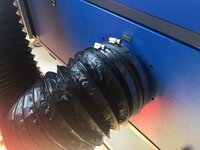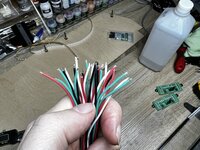Just to kick off this party, don't get a laser head for your desktop CNC. Just don't.
Xenocrates wrote up a much better reason than I could possibly do, so here it is. Non-quoted so the whole thing shows.
=== Content by Xenocrates ===
An open air laser is dangerous as sin, and not half as fun. High power lasers work through thermal decomposition and ablation of the material. They are capable of permanently blinding people and animals with incidental (reflected) exposure. Cutting lasers are typically wavelengths that do not stimulate the blink response normally in humans, and as such, by the time the glare is bad enough for you to look away, you have done permanent damage.
Wear appropriate protective glasses, or ensure that another engineered protective measure (such as laser treated glass for the appropriate wavelength) is between you and any portion of the optical path at all times.
They are capable of generating toxic, corrosive, and otherwise awful gases. Cutting materials with chlorine in them can generate HCL or chlorine gas. Similar but worse hazards exist with fluorine-bearing materials. They are capable of ruining the optics and structure of the laser, as well generally being terrible for the health of everyone around.
Cutting even nominally laser-safe plywoods and glues generates carcinogenic fumes and particulates. Do not use without fume extraction. If you can smell the laser during function, you are exposed to airborne hazards, and should either wear a respirator rated for gasses and particulates, or increase fume extraction efforts.
Lasers if operated unattended, can and will catch fire. Do not use without a fire extinguisher suitable for electrical fires AND fires involving the materials you intend to cut.
Lasers without gas assisted cutting have minimal control over particle accumulation, and may cause damage to the lenses if not regularly serviced. A damaged lens can result in a rogue beam, causing injury or damage well outside of the expected area.
Lasers with gas assisted cutting may feed fresh oxygen into a fire, increasing it's intensity if using an oxidizing gas such as air or oxygen. Otherwise, they present an asphyxiation hazard.
CO2 based lasers use incredibly high voltages to stimulate lasing. DO NOT TOUCH ANY PORTION OF THE TUBE POWER SUPPLY, OR THE TUBE. YOU DO NOT HAVE THE CORRECT PROTECTIVE EQUIPMENT. Touching the tube with bare hands or contaminated gloves can cause a thermal gradient on the tube similar to old halogen bulbs, except more explosive.
=== End Content by Xenocrates ===
With that out of the way, what's your laser cutter setup? What do you do with it?
Xenocrates wrote up a much better reason than I could possibly do, so here it is. Non-quoted so the whole thing shows.
=== Content by Xenocrates ===
An open air laser is dangerous as sin, and not half as fun. High power lasers work through thermal decomposition and ablation of the material. They are capable of permanently blinding people and animals with incidental (reflected) exposure. Cutting lasers are typically wavelengths that do not stimulate the blink response normally in humans, and as such, by the time the glare is bad enough for you to look away, you have done permanent damage.
Wear appropriate protective glasses, or ensure that another engineered protective measure (such as laser treated glass for the appropriate wavelength) is between you and any portion of the optical path at all times.
They are capable of generating toxic, corrosive, and otherwise awful gases. Cutting materials with chlorine in them can generate HCL or chlorine gas. Similar but worse hazards exist with fluorine-bearing materials. They are capable of ruining the optics and structure of the laser, as well generally being terrible for the health of everyone around.
Cutting even nominally laser-safe plywoods and glues generates carcinogenic fumes and particulates. Do not use without fume extraction. If you can smell the laser during function, you are exposed to airborne hazards, and should either wear a respirator rated for gasses and particulates, or increase fume extraction efforts.
Lasers if operated unattended, can and will catch fire. Do not use without a fire extinguisher suitable for electrical fires AND fires involving the materials you intend to cut.
Lasers without gas assisted cutting have minimal control over particle accumulation, and may cause damage to the lenses if not regularly serviced. A damaged lens can result in a rogue beam, causing injury or damage well outside of the expected area.
Lasers with gas assisted cutting may feed fresh oxygen into a fire, increasing it's intensity if using an oxidizing gas such as air or oxygen. Otherwise, they present an asphyxiation hazard.
CO2 based lasers use incredibly high voltages to stimulate lasing. DO NOT TOUCH ANY PORTION OF THE TUBE POWER SUPPLY, OR THE TUBE. YOU DO NOT HAVE THE CORRECT PROTECTIVE EQUIPMENT. Touching the tube with bare hands or contaminated gloves can cause a thermal gradient on the tube similar to old halogen bulbs, except more explosive.
=== End Content by Xenocrates ===
With that out of the way, what's your laser cutter setup? What do you do with it?







